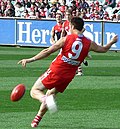Number (sports)
In team sports, the number, often referred to as the uniform number, squad number, jersey number, shirt number, sweater number, is the number worn on a player's uniform. It distinguishes each player from others wearing the same uniform. This is so that officials, scorers and spectators have something to identify each player. The number is usually shown on the back of the jersey. The player's surname is often written above or below the number. Sometimes the number also displayed on the front or sleeves, or on the player's shorts or headgear.
Number (sports) Media
Squad number, as depicted on an association football jersey
First use of numbers in South America: Scottish club Third Lanark and Argentine "Zona Norte" combined entering to the pitch with numbered jerseys, 10 June 1923
Nick Malceski executing a drop punt in 2006. In Australian rules football, squad numbers are not relevant to the player's position on the ground, although some clubs assign number 1 to captains.
Players of the Cleveland Indians wearing uniforms with numbers on their left sleeves in 1916. The Indians were the first team to introduce numbered uniforms in the MLB.
Although the NBA does not allow players to change numbers midseason, Andre Iguodala switched from number 4 to number 9 when Chris Webber arrived to the Sixers in 2005.
English cricketer Ben Stokes wearing 55 in a One Day International match v New Zealand, 2015. Players may choose their own numbers.
Sudhir Kumar Chaudhary, a fan of the Indian cricket team, travels to all Indian home games with his body painted as the Indian flag, along with the number of his idol Sachin Tendulkar
Quarterbacks, like Peyton Manning, generally possess a number from 1 to 19 per rules at most levels of American football.
Unlike American football, Canadian football has long allowed the use of the number 0, even at the professional level; it is often worn by defensive backs, like Rico Murray.









